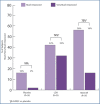Lisdexamfetamine dimesylate: the first prodrug stimulant
- PMID: 20532026
- PMCID: PMC2880945
Lisdexamfetamine dimesylate: the first prodrug stimulant
Abstract
Attention deficit hyperactivity disorder (ADHD) is one of the most common neurobehavioral disorders affecting children. The symptoms often persist into adolescence and adulthood, causing significant impairments. ADHD often remains undiagnosed and untreated, and because of its potential long-term impact, recognition, diagnosis, and management in children have become increasingly important. Education about ADHD and the available therapy options is important for both the patient and the caregiver to achieve more effective treatment. Efficacy and safety data on stimulant medications have provided evidence for their effectiveness in treating ADHD. Although they remain the first-line treatment, the need for multiple daily dosing and concerns about the general risk profile of stimulants have led to the development of new agents, including once-daily formulations that provide prolonged duration of action. However, pharmacokinetic variability of these formulations can result in inconsistent effects in some patients. The use of prodrug technology and the development of the only prodrug stimulant, lisdexamfetamine dimesylate (LDX), provide a promising treatment option for ADHD with an improved overdose potential risk profile when compared to d-amphetamine. This review of LDX, which presents the efficacy, safety, and pharmacokinetic profile of this new class of stimulant, is designed to help the physician better understand the clinical use of this agent in treating ADHD.
Keywords: ADHD; Vyvanse; lisdexamfetamine dimesylate; prodrugs; stimulant medications.
Figures
Similar articles
-
The efficacy and safety profile of lisdexamfetamine dimesylate, a prodrug of d-amphetamine, for the treatment of attention-deficit/hyperactivity disorder in children and adults.Clin Ther. 2009 Jan;31(1):142-76. doi: 10.1016/j.clinthera.2009.01.015. Clin Ther. 2009. PMID: 19243715 Review.
-
Review of Lisdexamfetamine Dimesylate in Adults With Attention-Deficit/Hyperactivity Disorder.J Cent Nerv Syst Dis. 2017 Aug 23;9:1179573517728090. doi: 10.1177/1179573517728090. eCollection 2017. J Cent Nerv Syst Dis. 2017. PMID: 28855799 Free PMC article. Review.
-
Review of lisdexamfetamine dimesylate in children and adolescents with attention deficit/hyperactivity disorder.Curr Med Res Opin. 2020 Oct;36(10):1717-1735. doi: 10.1080/03007995.2020.1815002. Epub 2020 Sep 11. Curr Med Res Opin. 2020. PMID: 32845786
-
Lisdexamfetamine dimesylate: a prodrug stimulant for the treatment of ADHD in children and adults.CNS Spectr. 2010 May;15(5):315-25. doi: 10.1017/s1092852900027541. CNS Spectr. 2010. PMID: 20448522 Review.
-
Lisdexamfetamine in the treatment of adolescents and children with attention-deficit/hyperactivity disorder.Adolesc Health Med Ther. 2012 May 8;3:51-66. doi: 10.2147/AHMT.S19815. eCollection 2012. Adolesc Health Med Ther. 2012. PMID: 24600287 Free PMC article. Review.
Cited by
-
Lisdexamfetamine Dimesylate: A Review in Paediatric ADHD.Drugs. 2018 Jul;78(10):1025-1036. doi: 10.1007/s40265-018-0936-0. Drugs. 2018. PMID: 29923015 Review.
-
An Infant with a Prolonged Sympathomimetic Toxidrome after Lisdexamfetamine Dimesylate Ingestion.J Med Toxicol. 2016 Dec;12(4):402-405. doi: 10.1007/s13181-016-0560-x. Epub 2016 Jun 8. J Med Toxicol. 2016. PMID: 27277955 Free PMC article.
-
Update on optimal use of lisdexamfetamine in the treatment of ADHD.Neuropsychiatr Dis Treat. 2013;9:977-83. doi: 10.2147/NDT.S34092. Epub 2013 Jul 22. Neuropsychiatr Dis Treat. 2013. PMID: 23901276 Free PMC article.
-
Safety of Stimulants Across Patient Populations: A Meta-Analysis.JAMA Netw Open. 2025 May 1;8(5):e259492. doi: 10.1001/jamanetworkopen.2025.9492. JAMA Netw Open. 2025. PMID: 40343695 Free PMC article.
-
Potential adverse effects of amphetamine treatment on brain and behavior: a review.Mol Psychiatry. 2009 Feb;14(2):123-42. doi: 10.1038/mp.2008.90. Epub 2008 Aug 12. Mol Psychiatry. 2009. PMID: 18698321 Free PMC article. Review.
References
-
- Biederman J, Faraone SV. Attention-deficit hyperactivity disorder. Lancet. 2005;366:237–48. - PubMed
-
- Spencer TJ, Adler LA, McGough JJ, et al. and The Adult ADHD Research Group. Efficacy and safety of dexmethylphenidate extended-release capsules in adults with attention-deficit/hyperactivity disorder. Biol Psychiatry. 2007;61:1380–7. - PubMed
-
- McGough JJ, Barkley RA. Diagnostic controversies in adult attention deficit hyperactivity disorder. Am J Psychiatry. 2004;161:1948–56. - PubMed
-
- Faraone SV, Biederman J, Mick E. The age-dependent decline of attention deficit hyperactivity disorder: A meta-analysis of follow-up studies. Psychol Med. 2006;36:159–65. - PubMed
LinkOut - more resources
Full Text Sources
Other Literature Sources

